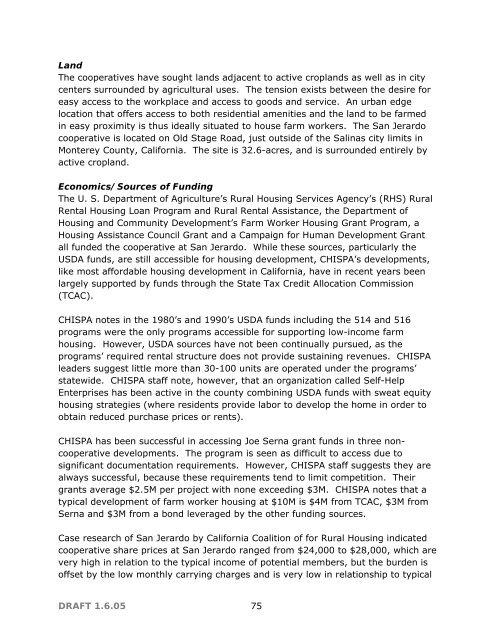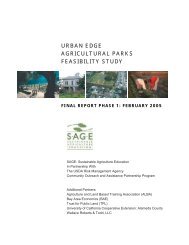A Feasibility Study for Urban Edge Agricultural Parks - SAGE
A Feasibility Study for Urban Edge Agricultural Parks - SAGE
A Feasibility Study for Urban Edge Agricultural Parks - SAGE
Create successful ePaper yourself
Turn your PDF publications into a flip-book with our unique Google optimized e-Paper software.
LandThe cooperatives have sought lands adjacent to active croplands as well as in citycenters surrounded by agricultural uses. The tension exists between the desire <strong>for</strong>easy access to the workplace and access to goods and service. An urban edgelocation that offers access to both residential amenities and the land to be farmedin easy proximity is thus ideally situated to house farm workers. The San Jerardocooperative is located on Old Stage Road, just outside of the Salinas city limits inMonterey County, Cali<strong>for</strong>nia. The site is 32.6-acres, and is surrounded entirely byactive cropland.Economics/Sources of FundingThe U. S. Department of Agriculture’s Rural Housing Services Agency’s (RHS) RuralRental Housing Loan Program and Rural Rental Assistance, the Department ofHousing and Community Development’s Farm Worker Housing Grant Program, aHousing Assistance Council Grant and a Campaign <strong>for</strong> Human Development Grantall funded the cooperative at San Jerardo. While these sources, particularly theUSDA funds, are still accessible <strong>for</strong> housing development, CHISPA’s developments,like most af<strong>for</strong>dable housing development in Cali<strong>for</strong>nia, have in recent years beenlargely supported by funds through the State Tax Credit Allocation Commission(TCAC).CHISPA notes in the 1980’s and 1990’s USDA funds including the 514 and 516programs were the only programs accessible <strong>for</strong> supporting low-income farmhousing. However, USDA sources have not been continually pursued, as theprograms’ required rental structure does not provide sustaining revenues. CHISPAleaders suggest little more than 30-100 units are operated under the programs’statewide. CHISPA staff note, however, that an organization called Self-HelpEnterprises has been active in the county combining USDA funds with sweat equityhousing strategies (where residents provide labor to develop the home in order toobtain reduced purchase prices or rents).CHISPA has been successful in accessing Joe Serna grant funds in three noncooperativedevelopments. The program is seen as difficult to access due tosignificant documentation requirements. However, CHISPA staff suggests they arealways successful, because these requirements tend to limit competition. Theirgrants average $2.5M per project with none exceeding $3M. CHISPA notes that atypical development of farm worker housing at $10M is $4M from TCAC, $3M fromSerna and $3M from a bond leveraged by the other funding sources.Case research of San Jerardo by Cali<strong>for</strong>nia Coalition of <strong>for</strong> Rural Housing indicatedcooperative share prices at San Jerardo ranged from $24,000 to $28,000, which arevery high in relation to the typical income of potential members, but the burden isoffset by the low monthly carrying charges and is very low in relationship to typicalDRAFT 1.6.05 75





